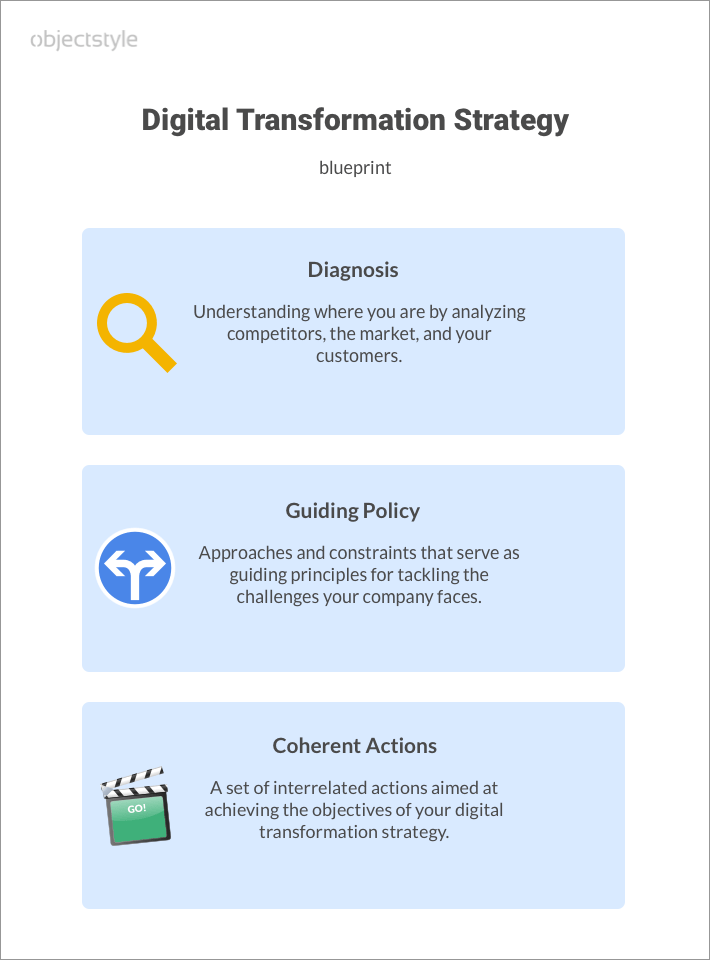
Companies look to create a digital transformation strategy because they wish to maximize their use of technology to gain competitive advantage. First off, let us define the term.
What is a digital transformation strategy?
Let’s take a look at each word in this term. “Digital” means that the change is enabled by the use of electronic technology.
The word “transformation” points to the idea that it’s a long-term commitment that changes your business in a major way. If you decide to automate one manual, time-consuming process with technology, that’s not “digital transformation” yet. Although you may safely call it “digitization.”
The word “strategy” means that it is not simply an idea or individual tactic. For example, “Let’s use digital queues instead of physical ones” is only an optimization tactic. A strategy should include a number of interconnected measures that bring about significant change.
A digital transformation strategy is a coherent set of actions taken to transform an organization into a competitive digital economy player.
Digital transformation strategy components
A lot of digital transformation consultancies use the paradigm outlined by Richard Rumelt in his book “Good Strategy, Bad Strategy.” The book describes the so-called “strategy kernel,” which consists of three components:
- Diagnosis
- Guiding Policy
- Coherent Actions
Without these three components, you can’t have a solid strategy (of any kind).
Diagnosis means understanding your current situation as well as analyzing your competitors, the market, and your customers. To diagnose well, you will need data. Prepare to go an extra mile to find relevant data to the best of your ability. At this stage, you should define business challenges and opportunities.
Guiding Policy is a set of decisions you make that steer transformative action in a particular direction. You need to decide on the angle(s), from which you will approach the challenges you’re facing.
Coherent Actions are the tactics you use to reach your strategic objectives. They should be coherent, meaning they should support one another in hitting a common goal.

A digital transformation plan example
For instance, you run a telecom company that provides Internet services, among other things.
During the diagnosis stage, you discover that your company serves only 3.5% of the ISP market, which is dominated by big players. And you want a bigger market share. Your competitors offer big discounts to first-time users and have good prices. You can’t compete with them on price. However, from online forums, you learn that they provide mediocre customer support. People are not happy with how long they have to wait for help. Moreover, industry studies show that over 35% of existing customers terminate their contracts, because they move to a new location.
While creating a guiding policy, you make a decision to focus on (A) Internet speed, (B) customer service experience, and (C) providing more/better help to existing customers who wish to move to a new location. You also set temporal and financial constraints for achieving these strategic goals.
While coming up with a set of coherent actions, you make plans to renovate some of your equipment to speed up the connection. You also change how people call your support department: instead of taking them through various options (“for this, press that”), you give them a dedicated support line. Lastly, you begin to construct a new cell tower not far from a new apartment complex, to which many of your customers are moving. You also buy online ads targeted at users in that particular area (who have a competing ISP indicated as their provider), urging them to switch to your company, because you offer better speed.
After 5 to 7 months of consistent effort to implement your strategy, you notice that your market share grew from 3.5% to 12%. Voila!
Enabling digital transformation, a case study
Below we describe a project ObjectStyle did for a client in the legal niche. The project included measures that enabled digital transformation for the client, among other things.
Our client is a legal data company that collects and organizes data from various sources. It then makes the data available on demand for a fee. Besides, it offers paid APIs to long-term partners who also need these data.
ObjectStyle began working with the client before their digital transformation. We can observe the before and after differences very clearly.
Before. Initially, the legal data company in question was gathering a big part of their data manually. It was time-consuming and not very efficient. Besides, the main database and the search engine that make up the core of their business needed to be replaced with a newer technology, if the client wanted to preserve their competitive advantage in the future.
After. Together with the client, we identified process areas that could benefit from automation and, specifically, from new technologies like machine learning, natural language processing, and optical character recognition. Meanwhile, we migrated the old database to a modern environment and upgraded the search engine to ensure the smooth functioning of our client’s customers’ APIs.
In Conclusion
Every business faces unique challenges and has niche-specific digital opportunities available to it. However, general principles of creating a digital transformation strategy apply across industries.
First, a strategy is not a tactic or a set of unrelated measures. It’s a coherent set of actions. Second, before you determine the “game plan”, you need to thoroughly understand the situation at hand and where you are in terms of the market, the competition, and your positioning. Then your digital transformation journey will be a success.
Related Blogs

7 red flags to watch out for in a potential software vendor
LEARN MORE